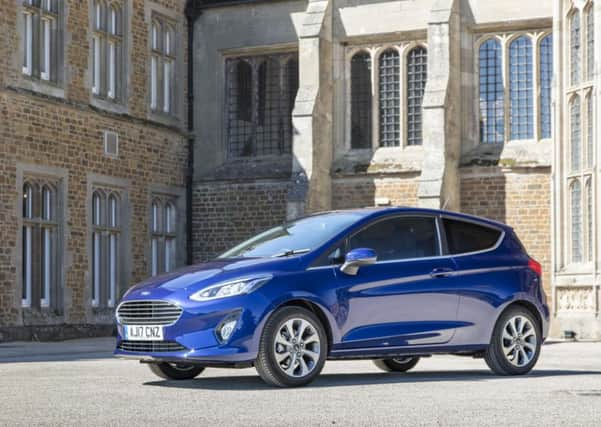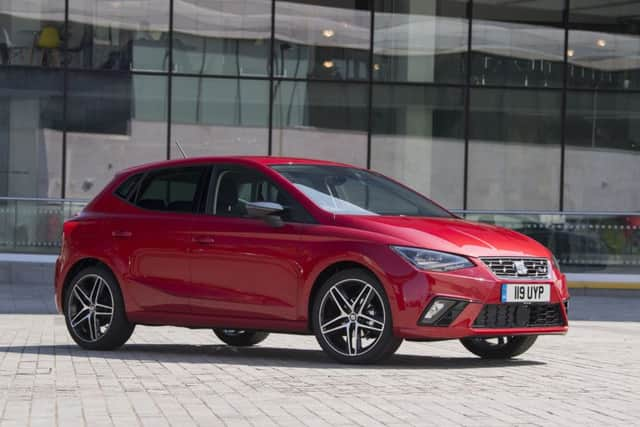Review: Seat Ibiza and Ford Fiesta


But it was ergonomically flawed. Porsche’s help with the gearbox and engine and a body by the eminent Italdesign and overseen by Germany’s Karmann set the Ibiza on track. But it didn’t even have column stalks – bizarrely, the easiest way to use some of the controls was by putting your hand through the steering wheel spokes.
In 1985 it was Seat’s entry to Britain. By then Volkswagen had taken over from Fiat as Seat’s partner, later to become its major shareholder.
Advertisement
Hide AdAdvertisement
Hide AdThe first Ibiza was plumper than the contemporary Fiesta, which was setting a high standard for the new wave of small family hatchbacks. Both had angular styling. The System Porsche plaque on its 1.5 litre engine got the Ibiza some kudos but as an unknown brand it was off to a slow start.


It caught up to be the brand’s vendedor número uno and a buoyant part of the VW Group. So far this year Seat is by far the group’s best performer in the UK.
The tape measure and the scale suggests that there’s little between today’s Fiesta and Ibiza. Inside, the Ibiza can pack in more cargo and give rear passengers a bit more head space and knee space.
I tried the two back to back. The Ibiza was the SE five-door hatch with VW’s high-tech 93.6bhp 999cc three-cylinder petrol turbo and a five-speed manual gearbox. It is rated at 60mpg, 106g CO2 and a 0-62mph time of 10.9 seconds. Cost: £14,595.
The five-door Fiesta Zetec had an 83.4bhp 1,084cc unblown four-cylinder petrol engine and five-speed gearbox. Ratings are 64mpg, 101g and 12.5 seconds for the sprint. Cost: £14,865.


This fifth generation Ibiza has been given first use of VW’s new chassis – which will be adopted by the VW Polo, Skoda Fabia and Audi A1. A longer wheelbase and smarter use of space gives passengers more room. The body shape is crisper, in tune with current trends at the Sitges style centre, south of the factory in Barcelona.
The engine was the mid-power version of three one-litre engines. A feisty 148bhp 1.5 petrol will follow, plus some 1.6 diesel engines. The SE is a core model but you’ll be tempted to add the £810 Apple Car Play, phone mirror link and Google connection, navigation and voice commands. A rear view camera is part of a £425 parking pack. The dark “mystery blue” metallic paint added £530.
Modern three-cylinder petrol turbo engines are excellent. The old-time throb has gone from most of them. The one in the Ibiza is a gem. With 1,18lb ft of torque in a one ton car it pulls well and in most respects this a very refined car and a credit to its makers. It is big enough for a family, and cute enough for singles of any age. It is economical too. In hill country and through conurbations it gave 50mpg, improving to 55mpg on a regular commuter run and nudging 59mpg on the motorway. Over a 300-mile return route with some country roads it recorded 57mpg. At 70mph the engine was running at 2,500rpm in fifth. Less good was the parking brake. The ratchet action sounded painful and it barely held the car on a slope.
Advertisement
Hide AdAdvertisement
Hide AdFord’s Fiesta is generally regarded as the bee’s knees. The latest brings new “connectivity” and a round of minor improvements to keep it on top of the charts. The core petrol engines are one-litre three-cylinder turbos but they cost more and have higher premiums than my 1.1-litre demonstrator – an attraction for younger drivers.
They are not short-changed on fun. This Fiesta is gruffer than the Ibiza and has a harsher low-speed ride. Fuel economy on similar routes was lower, averaging 49mpg over 170 miles of mixed driving and 51mpg on the commute. Cost: From £14,865. Extras included the rear view camera (£250), metallic paint (£495), the city safety pack (£300), powered rear windows (£175) and B&O audio and navigation (£600). Total: £17,220.
It has a high-level tablet-style information screen which looks awfully à la mode and usb ports for front and rear seats. Otherwise choosing between the instrumentation is a matter of taste. The reversing camera was welcome on both cars.
The Seat rake adjustment was hard to turn – many weaker drivers would have to do this from outside the car. Happily, I was for one night the grip champion of a fisherman’s bar in Honfleur – then the deposed champ returned, took a surprised look at me and raised the record. Stupidly, I tried again…
That was on a trip in my Mini Cooper with a schoolfriend, who died last month. It was a memorable drive, 48 years ago, through a France now altered, but I know there will be successors to my youth making their own memories with this new Fiesta. Its forte is the open road, curves and swerves and undulations which it – and you – just love. The steering has been made lighter and the balance and grip on relatively normal tyres is almost too enthusiastic. It’s a delight. It’s also slightly quicker than that 1965 Cooper. Maybe I should have repeated the drive to Honfleur and found that bar.
Verdict: I’d take the Ibiza for space and refinement and the Fiesta for sporting driving.